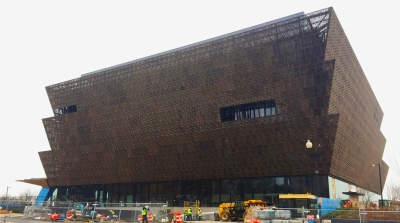Posted on
WASHINGTON (Dec. 10, 2015)—Lined with transcendent museums and monuments that are equally impressive in architecture and history, the National Mall is the symbolic epicenter of American pride and achievement.
But these iconic structures, particularly the United States Capitol and the White House, might not have existed if it weren’t, in part, for the uncredited work of both enslaved and free African Americans.
Now, the Smithsonian’s National Museum of African American History and Culture, a three-tier Yoruban-inspired structure, is being built to commemorate these unsung laborers as well as the rest of the African American community. And that museum, which is expected to open in the fall of 2016, is on the Mall—just steps from the Washington Monument.
To kick off the year-long countdown to its grand opening, the museum hosted a three-night event last month to celebrate the anniversaries of three major milestones in African American history: the ratification of the 13th Amendment to the Constitution, which abolished slavery 1865; the passage of the Voting Rights Act in 1965; and the end of the Civil War in 1865.
Lonnie Bunch, the founding director of the museum, called it “a dynamic event for the entire community.” Titled “Commemorate and Celebrate Freedom,” the free festivities drew hundreds of spectators and evoked visceral reactions.
Couples cupping hot beverages and young families toting blankets congregated on a mound just yards from the museum to snag the best seats on the knoll. Evening joggers and bikers also stopped in their tracks to marvel at the striking display.

The National Museum of African American History and Culture is expected to open in the fall of 2016. (Photo: Alessia Grunberger)
“I saw the structure, the corona. I was floored and I teared up,” Sharon Pendana, the author of “Secret Washington D.C.” said. “I mean, to think that this is coming and it’s a stone’s throw from the Washington Monument is pretty incredible—it’s remarkable.”
“Our stories have been, sort of, tamped down and it’s time that our stories are shared on a global level,” the Washington, D.C., native added.
But how can a museum evoke so many emotions if its interior is still under construction? The Smithsonian worked with what it had: a completed exterior.
“We were able to engage the public with the museum without them actually being able to enter the museum just yet,” said Tasha Coleman, the museum’s senior manager of donor and council relations. “We were excited to able to actually do that, especially given the museum’s irregular façade.”
The museum’s western and southern façades were transformed into a one-block-long 3-D canvas and projected seven minutes of images from moments in black history. The visual display ran continuously for all three nights.
“These are important milestones, I think not only in the African American experience, but also just the American story at large,” said Coleman. “I think that these milestones speak to the notion of freedom for all and the notion that should really be celebrated and brought to the forefront of our consciousness whenever possible. I know that this museum anticipates being a place that can facilitate that type of action.”
In addition to the colossal visual display, the event featured a live musical program, performances and poetry and remarks by Washington Mayor Muriel Bowser, Bunch and the city’s representative in the Congress, Del. Eleanor Holmes Norton.
“Everything about this is quite moving and my parents are both gone—they’ve deceased—and they would be so proud to know that this is here so that also made it particularly special for me,” Pendana said.
The 400,000-square-foot, $540 million museum will be home to three chronologically-organized history galleries, four community exhibitions that highlight African American trailblazers and four galleries that will celebrate African American culture and tradition.
Artifacts on display will include a restored Pullman railroad car from the segregation era to show how white and black passengers in the South were kept separated; and a guard tower and a cell from the Louisiana State Penitentiary in Angola, whose convict population at one time was predominantly African American and was abused and exploited.
Also on display will be more uplifting mementos, like an open-seat biplane used to train African American pilots in World War II who became known as the “Tuskegee Airmen,” Louis Armstrong’s horn, Harriet Tubman’s hymn book and protective headgear for firemen developed by an African American inventor.
“At the core of this museum, there’s this notion of dialogue, and healing, and reconciliation,” Coleman said. “While this museum will remember the past, I think it’s also going to serve as a place that’s going to document and surface current issues.”
“It’s also really going to be a hub of discourse, dialogue and conversation about relevant, present moments,” she added. “The African American experience didn’t stop at a certain point, it continues and this museum, while this is a history museum, is also a museum of community and it is also a museum of culture.”


